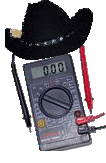|
The Plan
The Fluke
289 is a 50000 count meter with a ¼ VGA screen that has an AC
accuracy of ±0.3% + 25 digits from 45 to 65 HZ and a DC accuracy
of ±0.025% +25 digits. It is not a calibration standard but may
be the next best thing. My idea was to do a consumer report-like
comparison of DMMs by measuring AC and DC voltages relative to
the Fluke 289.
Measurements were taken during the March AHARS buy and sell,
using 12 meters belonging to members, in addition to some of my
own.
The Test Setup
The test
setup utilized two regulated DC voltage sources (Heathkit) and a
pure sine wave inverter with an autotransformer for a range of
AC voltages. A board with multiple binder posts was used to
connect the power supplies, the 289 and a test meter for
simultaneous measurements. The regulated DC supplies and the
battery power inverter assured a stable voltage while the
readings were recorded. A form was prepared to record details
about each meter, and the measured readings from the Fluke 289
and the test instrument. The voltages for the comparison were
approximately:
|
AC Test Voltage |
DC Test Voltage |
|
67 |
5 |
|
135 |
40 |
|
220 |
400 |
Each member
was given a written record of the measurement results for their
meter.
The Meters
Meters from
AHARS members included a Fluke 21, DSE Q-1559, Phillips
analogue, Fluke 75, Aulec DMM, Brymen BM 727, DSE Q-1419,
DT9205A, SOAR ME531, Parameters 7080B, Fluke 8022A, and an
unknown DMM. From my collection, I provided a Heathkit IM-2215,
Digitech QM-1536, Digitech QM-1500, Meterman DM78A and Triplett
2030. The age of the tested meters varied from less than 1 year
to over 25 years. All were DMMs except the Philips. The Meterman
and Triplett are both pocket-sized meters. The QM-1500 is a very
basic 3.5 digit DMM costing under $10. The QM-1536 is a 3 ¾
digit true RMS DMM with a specified accuracy of ±0.8%+1 digit
and ±1.0% +5 digits for DC and AC respectively.
RESULTS
All data was entered into an Excel
spreadsheet to calculate the percentage difference between the
readings of the Fluke 289 and the test meter, and the average of
the three AC and DC readings of each. The results were ranked
according to the average of the AC and DC measurements as shown
in the following table.
|
|
Manufacturer |
Model |
Type |
Average AC |
Average DC |
|
1 |
Fluke |
21 |
DMM |
0.11% |
0.16% |
|
2 |
Parameters |
7080B |
DMM |
0.07% |
0.21% |
|
3 |
Fluke |
75 |
DMM |
0.16% |
0.23% |
|
4 |
DSE |
Q-1419 |
DMM |
0.22% |
0.35% |
|
5 |
Fluke |
8022A |
DMM |
0.48% |
0.11% |
|
6 |
Triplett |
2030 |
DMM |
0.60% |
0.06% |
|
7 |
Brymen |
BM727 |
DMM |
0.42% |
0.28% |
|
8 |
(Aulec - CTC) |
DT9205A |
DMM |
0.68% |
0.03% |
|
9 |
Heathkit |
IM-2215 |
DMM |
0.63% |
0.09% |
|
10 |
DSE |
Q-1559 |
DMM |
0.83% |
0.13% |
|
11 |
Meterman |
DM78A |
DMM |
0.85% |
0.37% |
|
12 |
Aulec |
|
DMM |
1.01% |
0.38% |
|
13 |
Unknown |
8005 |
DMM |
1.23% |
0.62% |
|
14 |
Digitech |
QM-1536 |
DMM |
1.39% |
0.85% |
|
15 |
Digitech |
QM-1500 |
DMM |
1.70% |
0.83% |
|
16 |
Soar |
ME531 |
DMM |
3.51% |
1.76% |
|
17 |
Philips |
|
Analogue |
4.75% |
4.46% |
DISCUSSION
The DC
readings of 12 of the DMMs were within ½ % of the readings of
the Fluke 289 and within 1 % on AC. I was not able to get
specifications for all of the meters and so cannot comment on
how each meter performed relative to its specification. Overall,
with the exception of the Soar ME531, all of the DMMs appear to
be much more accurate than my initial experience with the
Digitech QM-1536 would have suggested. The results for the
analogue meter are consistent with that technology and clearly
indicate the value of DMMs.
Robin, VK5ATT. June 2008.
Many thanks to Robin (and XYL Carol, VK5KEY) for
their work on this project.
Footnote: Robin hails originally from New Mexico, hence the
Wild West connotation! (Ed)
RETURN to Newsletter Front Page
|


